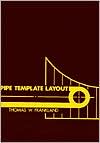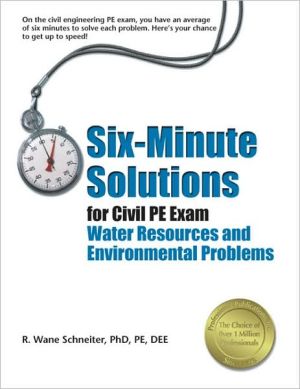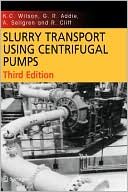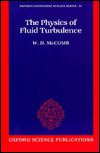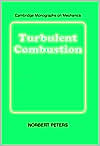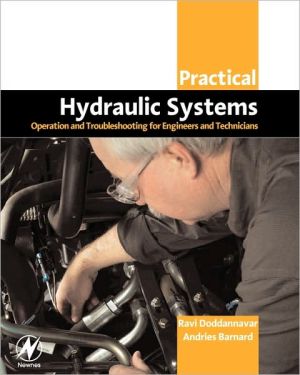Fundamentals of Hydraulic Engineering Systems
Fundamentals of Hydraulic Engineering Systems, Fourth Edition is a very useful reference for practicing engineers who want to review basic principles and their applications in hydraulic engineering systems. This fundamental treatment of engineering hydraulics balances theory with practical design solutions to common engineering problems. The author examines the most common topics in hydraulics, including hydrostatics, pipe flow, pipelines, pipe networks, pumps, open channel flow, hydraulic...
Search in google:
This book provides a fundamental treatment of engineeringhydraulics. It is intended to bridge the gap between basicprinciples and techniques applied to design and analysis ofhydraulic engineering systems. Booknews A textbook for a one-semester, three-hour undergraduate engineering course, with enough material to choose among several application chapters. A previous course is fluid mechanics is recommended but not required. For the third edition about half the problems are new are revised, a chapter is added on hydrology, and the use of a computer is encouraged for iterative problems. No dates are noted for the previous editions. Computer software is being developed to accompany the text. Annotation c. Book News, Inc., Portland, OR (booknews.com)
1 FUNDAMENTAL PROPERTIES OF WATER1.1 The Earth’s Atmosphere and Atmospheric Pressure1.2 The Three Phases of Water1.3 Mass (Density) and Weight (Specific Weight)1.4 Viscosity of Water1.5 Surface Tension and Capillarity1.6 Elasticity of Water1.7 Forces in a Fluid Field2 PRESSURE AND PRESSURE FORCES2.1 The Free Surface of Water2.2 Absolute and Gage Pressures2.3 Surfaces of Equal Pressure2.4 Manometers2.5 Hydrostatic Forces on Flat Surfaces2.6 Hydrostatic Forces on Curved Surfaces2.7 Buoyancy2.8 Flotation Stability3 WATER FLOW IN PIPES3.1 Description of Pipe Flow3.2 The Reynolds Number3.3 Forces in Pipe Flow3.4 Energy in Pipe Flow3.5 Loss of Head Due to Friction3.6 Empirical Equations for Friction Head Loss3.7 Friction Head Loss-Discharge Relationships3.8 Loss of Head in Pipe Contractions3.9 Loss of Head in Pipe Expansions3.10 Loss of Head in Pipe Bends3.11 Loss of Head in Pipe Valves3.12 Method of Equivalent Pipes3.12.1 Pipes in Series3.12.2 Pipes in Parallel4 PIPELINES AND PIPE NETWORKS4.1 Pipelines Connecting Two Reservoirs4.2 Negative Pressure Scenarios (Pipelines and Pumps)4.3 Branching Pipe Systems4.4 Pipe Networks4.4.1 The Hardy Cross Method4.4.2 The Newton Method4.5 Water Hammer Phenomenon in Pipelines4.6 Surge Tanks5 WATER PUMPS5.1 Centrifugal (Radial Flow) Pumps5.2 Propeller (Axial Flow) Pumps5.3 Jet (Mixed Flow) Pumps5.4 Centrifugal Pump Characteristic Curves5.5 Single Pump and Pipeline Analysis5.6 Pumps in Parallel or in Series5.7 Pumps and Branching Pipes5.8 Pumps and Pipe Networks5.9 Cavitation in Water Pumps5.10 Specific Speed and Pump Similarity5.11 Selection of a Pump6 WATER FLOW IN OPEN CHANNELS6.1 Open Channel Flow Classifications6.2 Uniform Flow in Open Channels6.3 Hydraulic Efficiency of Open Channel Sections6.4 Energy Principles in Open Channel Flow6.5 Hydraulic Jumps6.6 Gradually Varied Flow6.7 Classifications of Gradually Varied Flow6.8 Computation of Water Surface Profiles6.9 Hydraulic Design of Open Channels7 GROUND WATER HYDRAULICS7.1 Movement of Ground Water7.2 Steady Radial Flow to a Well7.2.1 Steady Radial Flow in Confined Aquifers7.2.2 Steady Radial Flow in Unconfined Aquifers7.3 Unsteady Radial Flow to a Well7.3.1 Unsteady Radial Flow in Confined Aquifers7.3.2 Unsteady Radial Flow in Unconfined Aquifers7.4 Field Determination of Aquifer Characteristics7.4.1 Equilibrium Test in Confined Aquifers7.4.2 Equilibrium Test in Unconfined Aquifers7.4.3 Nonequilibrium Test7.5 Aquifer Boundaries7.6 Surface Investigations of Ground Water7.6.1 The Electrical Resistivity Method7.6.2 Seismic Wave Propagation Methods7.7 Sea Water Intrusion in Coastal Areas7.8 Seepage Through Dam Foundations7.9 Seepage Through Earth Dams8 HYDRAULIC STRUCTURES8.1 Functions of Hydraulic Structures8.2 Dams-Functions and Classifications8.3 Stability of Gravity and Arch Dams8.3.1 Gravity Dams8.3.2 Arch Dams8.4 Small Earth Dams8.5 Weirs8.6 Overflow Spillways8.7 Side-Channel Spillways8.8 Siphon Spillways8.9 Culverts8.10 Stilling Basins9 WATER PRESSURE, VELOCITY, AND DISCHARGEMEASUREMENTS9.1 Pressure Measurements9.2 Velocity Measurements9.3 Discharge Measurements in Pipes9.4 Discharge Measurements in Open Channels9.4.1 Sharp-Crested Weirs9.4.2 Broad-Crested Weirs9.4.3 Venturi Flumes10 HYDRAULIC SIMILITUDE AND MODEL STUDIES10.1 Dimensional Homogeneity10.2 Principles of Hydraulic Similitude10.3 Phenomena Governed by Viscous Forces — Reynolds NumberLaw10.4 Phenomena Governed by Gravity Forces — Froude NumberLaw10.5 Phenomena Governed by Surface Tension — Weber NumberLaw10.6 Phenomena Governed by Both Gravity and Viscous Forces10.7 Models for Floating and Submerged Bodies10.8 Open Channel Models10.9 The Pi-Theorem11 HYDROLOGY FOR HYDRAULIC DESIGN11.1 The Hydrologic Cycle11.2 Precipitation11.3 Design Storm11.4 Surface Runoff and Stream Flow11.5 Rainfall-Runoff Relationships — The Unit Hydrograph11.6 Rainfall-Runoff Relationships — SCS Procedures11.6.1 Losses from Rainfall and Rainfall Excess11.6.2 Time of Concentration11.6.3 SCS Synthetic Hydrograph11.6.4 Summary of SCS Procedure11.7 Storage Routing11.8 Hydraulic Design — The Rational Method11.8.1 Design of Stormwater Collection Systems11.8.2 Design of Stormwater Pipes12 STATISTICAL METHODS IN HYDROLOGY12.1 Concepts of Probability12.2 Statistical Parameters12.3 Probability Distributions12.3.1 Normal Distribution12.3.2 Log-Normal Distribution12.3.3 Gumbel Distribution12.3.4 Log-Pearson Type III Distribution12.4 Return Period and Hydrologic Risk12.5 Frequency Analysis12.5.1 Frequency Factors12.5.2 Testing Goodness of Fit12.5.3 Confidence Limits12.6 Frequency Analysis Using Probability Graphs12.6.1 Probability Graphs12.6.2 Plotting Positions12.6.3 Data Plotting and Theoretical Distributions12.6.4 Estimating Future Magnitudes12.7 Rainfall Intensity-Duration-Frequency Relationships12.8 Applicability of Statistical MethodsSYMBOLS ANSWERS TO SELECTED PROBLEMS INDEX
\ BooknewsA textbook for a one-semester, three-hour undergraduate engineering course, with enough material to choose among several application chapters. A previous course is fluid mechanics is recommended but not required. For the third edition about half the problems are new are revised, a chapter is added on hydrology, and the use of a computer is encouraged for iterative problems. No dates are noted for the previous editions. Computer software is being developed to accompany the text. Annotation c. Book News, Inc., Portland, OR (booknews.com)\ \


